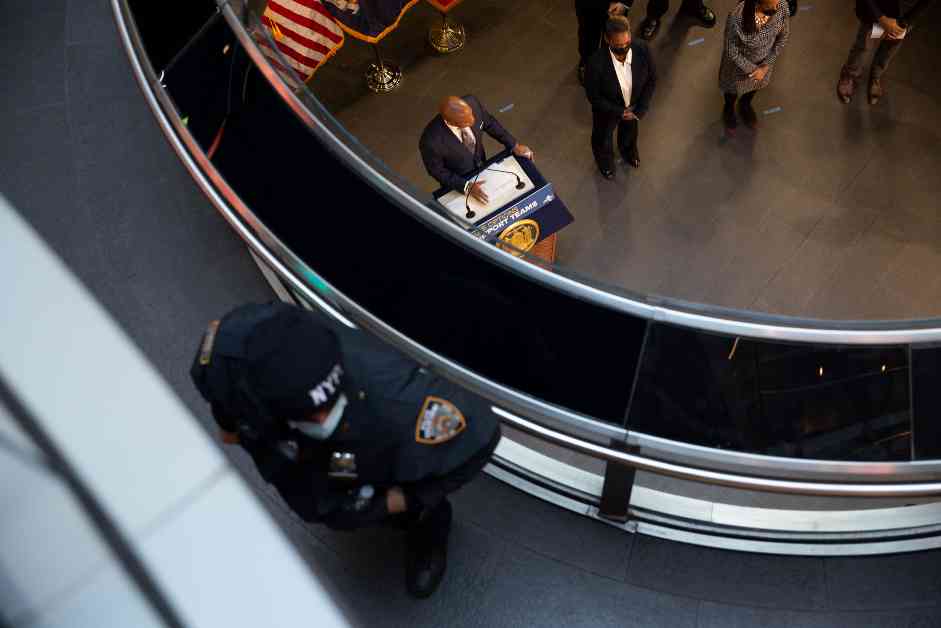NYPD Embedding Members in Civilian Agencies Amid Federal Investigation
In the midst of a federal investigation involving top officials in Mayor Eric Adams’ administration, the NYPD is expanding its role within civilian city agencies. One notable move is the assignment of Deputy Inspector Timothy Wilson as the “Chief of Enforcement” at the Department of Parks and Recreation, overseeing 250 Parks Enforcement Patrol officers. This initiative aims to enhance interagency coordination and streamline enforcement efforts across various city departments.
Initiative to Embed NYPD Officials in Local Government Agencies
The decision to embed NYPD members in civilian agencies is part of a larger initiative initiated by Mayor Adams. More than a dozen city agencies with enforcement units, including the departments of Homeless Services, Environmental Protection, and Health and Mental Hygiene, are expected to have NYPD officials assigned to them. These officials will undergo training at the Police Academy facility in Queens to ensure they are equipped to handle their enforcement duties effectively.
Parks Commissioner Sue Donoghue’s memo highlights the specific responsibilities of the new NYPD chief enforcement officer at the Parks Department, which include addressing illegal vending on parkland, permit enforcement, recruitment efforts to reduce attrition, expanding the agency’s drone unit, and fostering collaboration with the NYPD to support PEP officers. This strategic placement of NYPD personnel within civilian agencies underscores the administration’s commitment to improving enforcement operations citywide.
Concerns and Criticisms Surrounding NYPD’s Expanded Role
While the move to embed NYPD officials in civilian agencies is aimed at enhancing enforcement capabilities, it has also raised concerns among some stakeholders. Joe Puleo, president of District Council 37 Local 983 representing park patrol officers, expressed outrage over the perceived overreach by the NYPD in directing their members without proper acknowledgment. He emphasized that park patrol officers were not intended to function as armed police officers but rather as stewards providing comfort and information within city parks.
Puleo’s concerns about the “hardcore” enforcement culture brought by the NYPD into civilian agencies highlight the potential clash of organizational cultures and operational approaches. The absorption of enforcement units from various city agencies into the NYPD has led to apprehensions about bureaucratic control and the dilution of community-focused services. Puleo’s upcoming meeting with the NYPD to address these issues underscores the need for transparent communication and collaboration in implementing these organizational changes.
Elizabeth Glazer, former head of the Mayor’s Office of Criminal Justice, questioned the wisdom of turning every type of patrol into a police matter, especially in light of ongoing governance challenges within the Police Department. She emphasized the importance of exploring alternative, civil methods to address enforcement issues rather than solely relying on law enforcement solutions. Glazer’s insights shed light on the complex dynamics at play as the NYPD expands its influence within civilian agencies.
Implications of NYPD’s Expanded Role Amid Federal Investigation
The timing of the NYPD’s expanded role within civilian agencies amid a federal corruption probe involving top officials in Mayor Adams’ administration raises questions about the potential impact on governance and accountability. The federal investigation, which recently targeted Police Commissioner Edward Caban and other high-ranking NYPD officials, has cast a shadow over the administration’s efforts to strengthen enforcement operations through the placement of NYPD members in key positions.
The allegations of misconduct surrounding James Caban’s consulting work with nightlife establishments and the subsequent FBI raids on various officials underscore the challenges facing the NYPD as it navigates internal and external scrutiny. The deployment of high-ranking NYPD officials into civilian agencies adds another layer of complexity to the ongoing investigation, as questions about oversight, transparency, and accountability come to the forefront.
In light of these developments, Mayor Adams’ administration must navigate the delicate balance between enhancing enforcement capabilities and ensuring ethical conduct within the ranks of the NYPD. The collaboration between civilian agencies and the NYPD can yield positive outcomes in terms of coordination and efficiency, but it also requires robust mechanisms for oversight and accountability to prevent potential abuses of power or conflicts of interest.
As the federal investigation unfolds and the NYPD’s expanded role within civilian agencies takes shape, stakeholders across the city will be closely monitoring the implications of these organizational changes on public safety, governance, and community relations. The challenges and opportunities presented by the integration of law enforcement functions across city departments underscore the need for proactive communication, stakeholder engagement, and transparency in shaping the future of enforcement operations in New York City.
